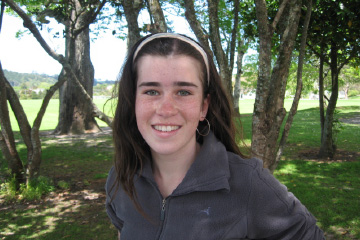I thought it was naturally a muddy brown colour
Forum South-East Asian Survey Congress
My name is Rebekah Liebezeit.

Infiltration Concern: Rebekah tells the South-East Asian Survey Congress, ‘It makes you think twice before swimming in the river!’ Photographer Richard Bromley
I am 13 years old and I live in the Mahurangi area, one hour north of Auckland.
I am also part of the group called the Stream Rescue Team. This group of about fifteen students concentrates on improving and restoring the local streams and the Mahurangi River.
My passions are the outdoors and the environment. I also love horses especially my boy, Quinn.
I hope our talk inspires you and that you learn something new today.
I have been part of the Auckland Regional Council’s Mahurangi Action Plan for three, almost four, years. Before I joined the action plan, I was completely ignorant of what the Mahurangi River was becoming. I simply thought of it as a channel of water running its own course through the Mahurangi catchment being affected by no one.
I thought it was naturally a muddy brown colour and that the riverbed was naturally covered in a thick sludgy mud.
When I joined the Mahurangi Action Plan I was astounded to discover that the river is not naturally brown and full of silt and pollution.
All streams throughout the Mahurangi catchment feed into the Mahurangi River, all 180 of them. A lot of these streams begin on farmland and travel down. If the farmer does not have his stream fenced and protected with native trees, stock erode the banks, causing loose sediment to fall into the stream. The stream continues running its course full of loose sediment. This in turn ends up in the river. Native trees stabilize the banks with their roots, keeping them from eroding.
It is not just farmers who have a part to play in the amount of sediment entering the harbour. The district council has a huge part to play in the amount of pollution entering the river. Every week, thousands of litres of untreated sewage are poured into the Mahurangi River. Why?
The sewerage system in Warkworth is large enough to cope with Warkworth’s sewage treatment needs, however many Warkworth residential property’s have their storm-water connected directly to the sewer. Therefore, when it rains, copious amounts of water rushes into the sewer, completely foiling the system and discharging raw untreated sewage into the Mahurangi River.
The district council has done nothing to control and stop this pollution entering the receiving environment.
It makes you think twice before swimming in the river.
Rebekah Leibeziet’s Vision
I would like to see less impermeable surfaces, more rain gardens and much more use of low impact design. People need to work together as a team if we are to have healthy waterways that are able to sustain both animal and human life.
Stream Rescue Team
- Tegan Illingworth
- Rebekah Leibeziet
- Georgia Monks
- Lottie Thompson
- Sarah Thoroughgood
See also Presenters Warm Up
